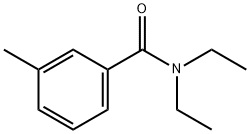134-62-3

Product Name:
N,N-Diethyl-m-toluamide
Formula:
C12H17NO
Synonyms:
m-Toluic acid diethylamide;N,N-Diethyl-m-toluamide;N,N-Diethyl-3-methylbenzamide;DEET
Inquiry
CHEMICAL AND PHYSICAL PROPERTIES
| Physical Description | N,n-diethyl-m-toluamide appears as clear colorless or faintly yellow slightly viscous liquid. Faint pleasant odor. (NTP, 1992) |
|---|---|
| Color/Form | Nearly colorless to amberlike liquid |
| Odor | Faint, characteristic odor |
| Boiling Point | 545 °F at 760 mmHg (NTP, 1992) |
| Melting Point | -49 °F (pour point) (NTP, 1992) |
| Flash Point | 311 °F (NTP, 1992) |
| Solubility | 19.6 [ug/mL] (The mean of the results at pH 7.4) |
| Density | 0.996 at 68 °F (NTP, 1992) - Less dense than water; will float |
| Vapor Density | 6.7 (NTP, 1992) - Heavier than air; will sink (Relative to Air) |
| Vapor Pressure | 1 mmHg at 232 °F ; 19 mmHg at 320 °F (NTP, 1992) |
| LogP | log Kow = 2.02 |
| Stability/Shelf Life | Stable under recommended storage conditions. |
| Decomposition | When heated to decomposition it emits toxic fumes of /nitrogen oxides/. |
| Viscosity | 13.3 cP at 30 °C |
| Refractive Index | Index of refraction: 1.5212 at 20 °C/D |
| Collision Cross Section | 143.2 Ų [M+H]+ [CCS Type: TW, Method: calibrated with polyalanine and drug standards] |
| Kovats Retention Index | 1571 1571 1583 269.36 |
| Other Experimental Properties | Hygroscopic. Light sensitive |
| Chemical Classes | Pesticides -> Insect Repellents |
SAFETY INFORMATION
| Signal word | Warning |
|---|---|
| Pictogram(s) |
 Exclamation Mark Irritant GHS07 |
| GHS Hazard Statements |
H302:Acute toxicity,oral H315:Skin corrosion/irritation H319:Serious eye damage/eye irritation H412:Hazardous to the aquatic environment, long-term hazard |
| Precautionary Statement Codes |
P264:Wash hands thoroughly after handling. P264:Wash skin thouroughly after handling. P270:Do not eat, drink or smoke when using this product. P273:Avoid release to the environment. P301+P312:IF SWALLOWED: call a POISON CENTER or doctor/physician IF you feel unwell. P302+P352:IF ON SKIN: wash with plenty of soap and water. P305+P351+P338:IF IN EYES: Rinse cautiously with water for several minutes. Remove contact lenses, if present and easy to do. Continuerinsing. |
COMPUTED DESCRIPTORS
| Molecular Weight | 191.27 g/mol |
|---|---|
| XLogP3 | 2 |
| Hydrogen Bond Donor Count | 0 |
| Hydrogen Bond Acceptor Count | 1 |
| Rotatable Bond Count | 3 |
| Exact Mass | 191.131014166 g/mol |
| Monoisotopic Mass | 191.131014166 g/mol |
| Topological Polar Surface Area | 20.3 Ų |
| Heavy Atom Count | 14 |
| Formal Charge | 0 |
| Complexity | 187 |
| Isotope Atom Count | 0 |
| Defined Atom Stereocenter Count | 0 |
| Undefined Atom Stereocenter Count | 0 |
| Defined Bond Stereocenter Count | 0 |
| Undefined Bond Stereocenter Count | 0 |
| Covalently-Bonded Unit Count | 1 |
| Compound Is Canonicalized | Yes |
PRODUCT INTRODUCTION
description
DEET is a chemical (N,N-diethyl-meta-toluamide) used as the active ingredient in many insect repellent products. DEET was developed by the U.S. Army in 1946 and was registered for use by the general public in 1957. It is now widely used, with approximately 30% of the U.S. population using DEET repellents each year. DEET products are currently available in a variety of forms: liquids, lotions, sprays, and even impregnated materials, such as wristbands. Formulations registered for direct application to human skin contain from 4% to 100% DEET. Approximately 230 products containing DEET are currently registered with the U.S. Environmental Protection Agency (EPA).
